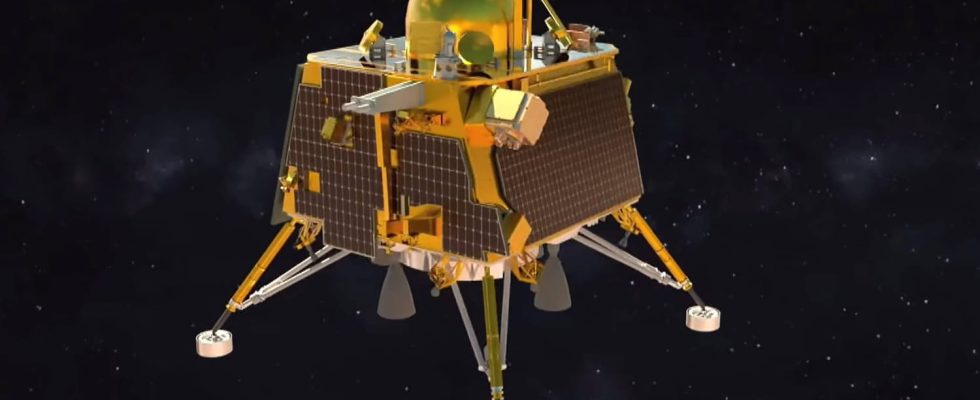CHANDRAYAAN-3. The Indian space mission ended 15 days after its arrival on the Moon. A look back at the discoveries and results of an already historic mission.
On August 23, 2023, theIndia hit hard by landing its first space probe on the Moon, becoming the fourth nation to achieve this feat. The landing of Chandrayaan-3 took place in the South Pole region of the Moon, a difficult to access and highly coveted region of our natural satellite. After two weeks of exploration and scientific measurements, the Vikram lander and the Pragyan rover had been put to sleep as the lunar night approached.
During its short period of activity on the surface of the Moon, Pragyan has not been idle. In fact, the rover had time to travel around a hundred meters, take a few photographs, take temperature measurements and various soil analyzes which revealed some surprises to the scientists. The valuable data collected in this way was sent to the mission’s scientific team before the machines were put on standby. Let’s take stock of the progress of the mission and its discoveries.
What did the Chandrayaan-3 mission to the Moon discover?
The multiple measuring instruments with which the lander and the rover of the Chandrayaan-3 mission are equipped have made it possible to carry out some analyzes of the lunar soil. The discoveries thus made represented a considerable scientific contribution and were the occasion for some surprises.
Using the probe and thermal sensors fitted to the lander, mission scientists discovered that the temperature dropped very quickly in the first few centimeters of the lunar surface. This temperature thus went from 60°C on the surface to -10°C at a depth of 8 centimeters.
The Pragyan rover had also studied the composition of the lunar soil, thus confirming for the first time the presence of sulfur which could be the result of past tectonic activity of the Moon. The measurements carried out also indicated the presence of other compounds such as aluminum, iron, chromium and titanium.
What are the photos taken by the Chandrayaan-3 probe?
As the space probe circled the Moon before landing, Chandrayaan-3 captured a series of snapshots released by the Indian Space Agency using its camera. We can see the hidden face of the Moon and its many craters:
Shortly after his first spins on the lunar surface, Pragyan had immortalized his first crater, a dangerous relief of 4 meters in diameter. The machine had to turn back to take a safer route.

On August 30, ISRO published this photo of the Vikram lander immortalized using the rover’s onboard camera:
Chandrayaan-3 is a space probe designed by the Indian Space Agency, ISRO, which was launched on July 14, 2023. Consisting of a lander that landed smoothly on the surface of the Moon and a a rover that descended from the landing module using an inclined ramp, this probe made several discoveries during its mission, which began in August 2023.
To carry out its mission, the Chandrayaan-3 probe embarked various instruments. The lander was notably equipped with a camera, a seismometer to study the ground of the Moon as well as several tools allowing it to carry out certain measurements and to analyze the lunar atmosphere. For its part, the rover had two spectroscopes to study the chemical nature of the lunar soil as well as several cameras. This probe succeeded Chandrayaan-2 which crashed on the surface of the Moon in July 2019.
Where had the Chandrayaan-3 probe landed on the Moon?
For the landing of the Chandrayaan-3 probe, ISRO had selected a site which lies between the Manzinus C and Simpelius N craters. This place is located not far from the South Pole of the Moon, a very rugged region dotted with craters and reliefs where the maneuver is particularly difficult to carry out. Before reaching its landing zone, the probe had completed several orbits around the Moon and then began its descent.
What were the objectives of the Chandrayaan-3 mission?
The Vikram lander, which means “valor” in Sanskrit, was tasked with studying the surface of the Moon. For this, he had to take an interest in its seismic and thermal characteristics, its geology as well as the gases that make up its meager atmosphere. For its part, the rover Pragyan meaning “wisdom” in Sanskrit, weighing 26 kg, was to concentrate its efforts on studying the composition of the soil from a chemical and mineralogical point of view.
 You can find more infographics at Statista
You can find more infographics at StatistaFinally, the Chandrayaan-3 mission was of strategic importance since it was India’s first lunar mission and enabled this country to become the 4e nation to place a probe on our natural satellite. India has thus joined the United States, Russia and China in the very private circle of powers having landed on the Moon. The number one objective of the Chandrayaan-3 mission rover was first to demonstrate that India was capable of achieving “safe travel on the lunar surface”, reads on the ISRO website.
